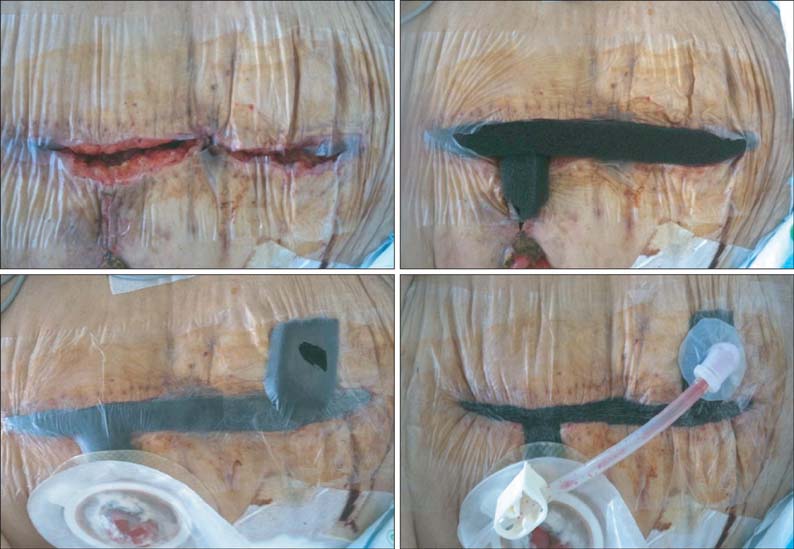J Korean Surg Soc.
2013 Oct;85(4):180-184. 10.4174/jkss.2013.85.4.180.
Application of negative pressure wound therapy in patients with wound dehiscence after abdominal open surgery: a single center experience
- Affiliations
-
- 1Department of Surgery, Yonsei University College of Medicine, Seoul, Korea. jakii@yuhs.ac
- 2Department of Surgery, Yonsei University Wonju College of Medicine, Wonju, Korea.
- 3Department of Wound Ostomy Continence Nursing, Severance Hospital, Seoul, Korea.
- KMID: 2096709
- DOI: http://doi.org/10.4174/jkss.2013.85.4.180
Abstract
- PURPOSE
Since the 1990's, negative pressure wound therapy (NPWT) has been used to treat soft tissue defects, burn wounds, and to achieve skin graft fixation. In the field of abdominal surgery, the application of NPWT is increasing in cases with an open abdominal wound requiring temporary wound closure and a second look operation. In the present study, the authors analyzed patients that underwent NPWT for postoperative wound dehiscence.
METHODS
The computerized records of patients that had undergone an abdominal operation from November 2009 to May 2012 were retrospectively analyzed.
RESULTS
The number of total enrolled patients was 50, and 30 patients (60%) underwent an emergency operation. Diagnoses were as follows: panperitonitis or intra-abdominal abscess (24 cases, 48%), intestinal obstruction (10 cases, 20%), cancer (7 cases, 14%), mesentery ischemia (3 cases, 6%), and hemoperitoneum (1 case, 2%). NPWT was applied at a mean of 12.9 +/- 8.2 days after surgery and mean NPWT duration was 17.9 days (2 to 96 days). The 11 patients (22%) with unsuccessful wound closure had a deeper and more complex wound than the other 39 patients (78%) (90.9% vs. 38.5%, P = 0.005). There were two complication cases (4%) due to delayed wound healing.
CONCLUSION
Most patients recovered well due to granulation formation and suturing. NPWT was found to be convenient and safe, but a prospective comparative study is needed to confirm the usefulness of NPWT in patients whose wounds are dehisced.
Keyword
MeSH Terms
Figure
Reference
-
1. Argenta LC, Morykwas MJ. Vacuum-assisted closure: a new method for wound control and treatment: clinical experience. Ann Plast Surg. 1997; 38:563–576.2. Morykwas MJ, Argenta LC, Shelton-Brown EI, McGuirt W. Vacuum-assisted closure: a new method for wound control and treatment: animal studies and basic foundation. Ann Plast Surg. 1997; 38:553–562.3. Caro A, Olona C, Jimenez A, Vadillo J, Feliu F, Vicente V. Treatment of the open abdomen with topical negative pressure therapy: a retrospective study of 46 cases. Int Wound J. 2011; 8:274–279.4. D'Hondt M, D'Haeninck A, Dedrye L, Penninckx F, Aerts R. Can vacuum-assisted closure and instillation therapy (VAC-Instill therapy) play a role in the treatment of the infected open abdomen? Tech Coloproctol. 2011; 15:75–77.5. Plaudis H, Rudzats A, Melberga L, Kazaka I, Suba O, Pupelis G. Abdominal negative-pressure therapy: a new method in countering abdominal compartment and peritonitis - prospective study and critical review of literature. Ann Intensive Care. 2012; 2:Suppl 1. S23.6. Batacchi S, Matano S, Nella A, Zagli G, Bonizzoli M, Pasquini A, et al. Vacuum-assisted closure device enhances recovery of critically ill patients following emergency surgical procedures. Crit Care. 2009; 13:R194.7. Wittmann DH, Aprahamian C, Bergstein JM, Edmiston CE, Frantzides CT, Quebbeman EJ, et al. A burr-like device to facilitate temporary abdominal closure in planned multiple laparotomies. Eur J Surg. 1993; 159:75–79.8. Kirshtein B, Roy-Shapira A, Lantsberg L, Mizrahi S. Use of the "Bogota bag" for temporary abdominal closure in patients with secondary peritonitis. Am Surg. 2007; 73:249–252.9. Arhi C, El-Gaddal A. Use of a silver dressing for management of an open abdominal wound complicated by an enterocutaneous fistula-from hospital to community. J Wound Ostomy Continence Nurs. 2013; 40:101–103.10. Ramirez OM, Ruas E, Dellon AL. "Components separation" method for closure of abdominal-wall defects: an anatomic and clinical study. Plast Reconstr Surg. 1990; 86:519–526.11. Bovill E, Banwell PE, Teot L, Eriksson E, Song C, Mahoney J, et al. Topical negative pressure wound therapy: a review of its role and guidelines for its use in the management of acute wounds. Int Wound J. 2008; 5:511–529.12. Armstrong DG, Lavery LA. Diabetic Foot Study Consortium. Negative pressure wound therapy after partial diabetic foot amputation: a multicentre, randomised controlled trial. Lancet. 2005; 366:1704–1710.13. Moisidis E, Heath T, Boorer C, Ho K, Deva AK. A prospective, blinded, randomized, controlled clinical trial of topical negative pressure use in skin grafting. Plast Reconstr Surg. 2004; 114:917–922.14. Barker DE, Kaufman HJ, Smith LA, Ciraulo DL, Richart CL, Burns RP. Vacuum pack technique of temporary abdominal closure: a 7-year experience with 112 patients. J Trauma. 2000; 48:201–206.15. Brace JA. Negative pressure wound therapy for abdominal wounds. J Wound Ostomy Continence Nurs. 2007; 34:428–430.16. Padalino P, Dionigi G, Minoja G, Carcano G, Rovera F, Boni L, et al. Fascia-to-fascia closure with abdominal topical negative pressure for severe abdominal infections: preliminary results in a department of general surgery and intensive care unit. Surg Infect (Larchmt). 2010; 11:523–528.17. Solomkin JS, Mazuski JE, Bradley JS, Rodvold KA, Goldstein EJ, Baron EJ, et al. Diagnosis and management of complicated intra-abdominal infection in adults and children: guidelines by the Surgical Infection Society and the Infectious Diseases Society of America. Surg Infect (Larchmt). 2010; 11:79–109.18. Baharestani MM, Gabriel A. Use of negative pressure wound therapy in the management of infected abdominal wounds containing mesh: an analysis of outcomes. Int Wound J. 2011; 8:118–125.19. Fry DE. Wound infection in hernia repair. In : Fitzgibbons RJ, Greenburg AG, editors. Nyhus and Condon's hernia. 5th ed. Philadelphia: Lippincott Williams & Wilkins;2002. p. 279–290.
- Full Text Links
- Actions
-
Cited
- CITED
-
- Close
- Share
- Similar articles
-
- Clinical Experience of Negative Pressure Wound Therapy with Instillation
- Effects of Preoperative Negative Pressure Wound Therapy on Complications after Musculocutaneous Flap Reconstruction of Sacral Pressure Injuries
- Vacuum-assisted close versus conventional treatment for postlaparotomy wound dehiscence
- Negative-Pressure Wound Therapy in a Patient with Osteomyelitis Caused by Multidrug-Resistant Bacterial Infection: A Case Report
- Combining Negative Pressure Wound Therapy with Shoelace Technique for Effective Closure of Soft Tissue Defect: A Case Series


